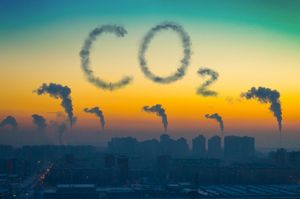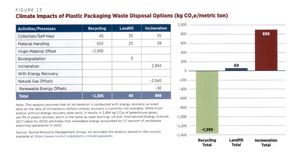Is climate protection possible without plastic?
Is climate protection possible without plastic?
| Author: Patrick Semadeni
Under the title ‘Klimakiller Kunststoff’ (‘Climate-killing plastic’) on its website, Greenpeace gives an account of the report "Plastic & Climate", which was published in May 2019. From production to disposal, a total of 850 million tons of CO2 is expected to be released into the atmosphere in 20191. However, according to the IPCC, greenhouse gas emissions were 53.5 gigatons of CO2 equivalents worldwide2. With a proportion of 1.6%, can we speak of climate killers? And is climate protection even possible at all without plastic?
Doing without plastic complicates achieving climate goals
Therefore, the study considers 1.6% of greenhouse gas emissions, according to their calculations. As a result, the approach of the study is definitely questionable.
The study claims to calculate the CO2 emissions of the entire life cycle of plastics. The following phases are included in this life cycle1:
- Fossil fuel extraction and transport
- Plastic refining and manufacture
- Managing plastic waste
- Ongoing impact in waterways, oceans, and landscape
What is missing is the use phase. And this is exactly where plastics play a decisive role in climate protection:
- Mobility: Vehicles, ships, railways, and airplanes are much lighter thanks to plastics and require less energy
- Heat: Plastics have a very low thermal conductivity and are the best material for building insulation
- Food Waste: massive food waste can be saved through adequate plastic packaging, and fewer new foods have to be produced
- Recycling: plastic recycling is less energy intensive, due to its comparatively low melting point
Dispensing with plastic would make it impossible to achieve the Paris climate goals. Emission of greenhouse gases would triple!3
Environmental costs would rise from $139 billion to $533 billion.4
How plastic helps to reach the Paris climate goals
Mobility
Plastics have a specific weight (density) of around 1 g/cm3. Other materials used in vehicles, airplanes, and ships are much heavier5:
- Aluminum: 2.7 g/cm3
- Glass: 2.5 g/cm3
- Steel: 7.85 g/cm3
Swiss Plastics estimates that the use of plastics saves around 300 kg in weight for a mid-range car.6
In addition, new materials, such as plastic composites, offer additional opportunities in lightweight construction. The US Highway Authority let George Washington University calculate what weight savings could be achieved for a pick-up truck with the largest possible use of modern plastics such as composites. The result is impressive: the weight of a Chevrolet Silverado can be significantly reduced from 2.307 tons to 1.874 tons. That's an additional 19%!7
Without the use of plastics, mobility would cause many more CO2 emissions.
Building Insulation
Polyurethane (PUR) foams are used in building insulation. These have a thermal conductivity of 0.021 W / mK.8 In contrast, the thermal conductivity of alternative materials9:
- Wood fiber insulation board: 0.037..0.06 W/mK
- Wool: 0.035 W/mK
- Cork: 0.035..0.046 W/mK
- Glass foam granulate: 0.08 W/mK
- Concrete: 2.1 W/mK
Heating and electricity generate 25% of greenhouse gas emissions worldwide10.
CO2 emissions can be reduced by consistent insulation of buildings through PUR foams. If not, emissions would rise significantly, since alternative materials are worse at insulating!
Food Waste
About 1/3 of the food produced worldwide becomes food waste. That equates to a weight of a 1.3 billion tons!11
Thereby, sensible plastic packaging can help to significantly reduce food waste. Through less food waste, 270 g of CO2 are saved per kg of fresh food. The CO2 footprint of packaging is only 1.3%.12
Doing without plastic in food packaging would have fatal consequences for the CO2 footprint: many more new foods would have to be produced at enormously high environmental costs!
Recycling is the solution
In its plastics strategy, the EU Commission made clear its commitment to the recycling economy. It aims to use 10 million tons of recycled materials in Europe by 2025.13
The study also highlights the positive climate contribution of plastic recycling: per metric ton of recycled plastic, a CO2 equivalent of 1.395 tons is saved:
If it were possible to recycle around 70% of the plastics, there would be climate neutrality. Taking into account the CO2 savings in the use phase, this value may even be lower.
The entire value chain is required here, on the one hand, to design products that are easy to recycle (Design for Recycling) and, on the other hand, to accept and purchase recycled products.
Furthermore, we should forgo unnecessary packaging; the proportion of the plastic used must be reduced to the weight necessary to protect the contents or fulfill the function.
Sensible use of plastic combined with high recycling rates are necessary prerequisites for achieving the Paris climate goals.
Dispensing with plastics has a fatal effect on greenhouse gas emissions and accelerates global warming.
Reference:
1 Plastic & Climate, The hidden cost of a plastic planet, CIEL, Washington, 2019
2 UNEP, Emissions Gap Report 2018, Katowice
3 Prof. David Bucknall, Institute of Chemical Sciences, Herion-Watt University, zitiert in EuPC Conference, Berlin, 2019
4 Plastics and Sustainability : a valuation of environmental benefits, costs and opportunities for continuous improvement. American Chemistry Council / Trucost, New York, 2016
5 Wikipedia, 2019
6 Swiss Plastics, Aarau, 2018
7 Investigation of Opportunities for Leightweight Vehicels Using Advanced Plastics and Composites, US Dept. Of Transportation, NHTSA, Washington, 2012
8 Saechtling Kunststoff Taschenbuch Bauer et al., Hanser München, 2007
9 Wikipedia, 2019
10 IPCC, Climate Change 2014, Cambrige University Press, New York, 2014
11 Global Food Losses and Food Waste, FAO UN, Rom, 2011
12 How Packaging Contributes to Food Waste Prevention, Denkstatt, Wien, 2017
13 Eine europäische Strategie für Kunststoffe in der Kreislaufwirtschaft. Europäische Kommission, Brüssel, 16. Januar 2018






